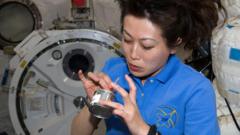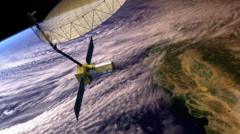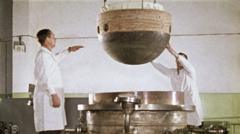A European Space Agency experiment has taken off to test the feasibility of lab-grown food production in space, which could lead to affordable and nutritious meals for astronauts and support future missions to the Moon and Mars.**
Revolutionizing Space Cuisine: The Quest for Lab-Grown Food in Orbit**

Revolutionizing Space Cuisine: The Quest for Lab-Grown Food in Orbit**
A groundbreaking experiment aimed at growing lab-grown foods in space has launched, promising to redefine astronaut diets and reduce food costs for long-term missions.**
A major step towards sustainable space exploration has been initiated with the launch of an ambitious experiment designed to cultivate lab-grown food in orbit. This effort is being spearheaded by the European Space Agency (ESA), aiming to ensure that astronauts can have nutritious and cost-effective meals as humanity ventures further into space.
The experiment, which began its journey into the cosmos today, will assess how well food ingredients like proteins and carbohydrates can be developed in the unique environment of low gravity and increased radiation. The objective is not only to make space travel more viable but also to cut down on the exorbitant costs of sending regular food supplies to astronauts, currently estimated to be around £20,000 per astronaut each day.
“If our goal of becoming a multi-planetary species is to be realized, we need to develop food production facilities both in orbit and on lunar surfaces,” explains Dr. Aqeel Shamsul, CEO of Frontier Space. The project follows hope for the establishment of a pilot food production plant at the International Space Station (ISS) over the next two years.
The concept of lab-grown food involves producing essential ingredients from cells using bioreactor technologies. Products like lab-grown chicken have already made their way to the market in the U.S., while lab-grown steak awaits clearance in various regions such as the UK and Israel. Such innovations hold promising implications for improving food sustainability on Earth, but in space, the main focus remains on minimizing transportation expenses.
Reflecting on the growing food in space, Dr. Shamsul mentioned, “We could start with simpler options like protein-rich mashed potatoes, and progress towards complex dishes made through 3D printing technologies. Imagine having the ability to print a steak in space.”
Currently, researchers have sent a smaller version of a bioreactor to space aboard the SpaceX Falcon 9 rocket that will evaluate whether the growth of food can be successfully replicated in space’s challenging conditions. Dr. Rodrigo Ledesma-Amaro, Director of the Bezos Centre, noted that successful bioreactor operations could lead to enhanced capabilities for producing various food components.
The preliminary experiment will last about three hours in orbit before returning to Earth near Portugal for analysis. The results will aid the design of a larger bioreactor slated for launch in the coming year. However, there’s a challenge—the initial products can be far from appetizing. To tackle this, culinary specialists, like Jakub Radzikowski from Imperial College, are developing recipes using natural food components while awaiting regulatory confirmations for lab-grown ingredients.
Radzkowski’s mission is to create familiar comfort food for astronauts, imagining everything from Indian to Chinese cuisines in space. As he develops dishes with fungi-derived starches, feedback sits with none other than Helen Sharman, the UK's first astronaut.
Sharman praised the potential for lab-grown food to cater to astronauts’ nutritional needs. “With lab-grown food, we can modify the ingredients to ensure adequacy in essential vitamins and minerals, thus making it a beneficial option for long-term space missions,” Sharman remarked. She highlighted that freshly prepared meals could enhance appetite and satisfaction among astronauts, ultimately supporting their health during prolonged missions.
As humanity eyes the stars, the trajectory of food production in space stands to revolutionize the future of interplanetary living, potentially making life beyond Earth tastier and more sustainable.

















